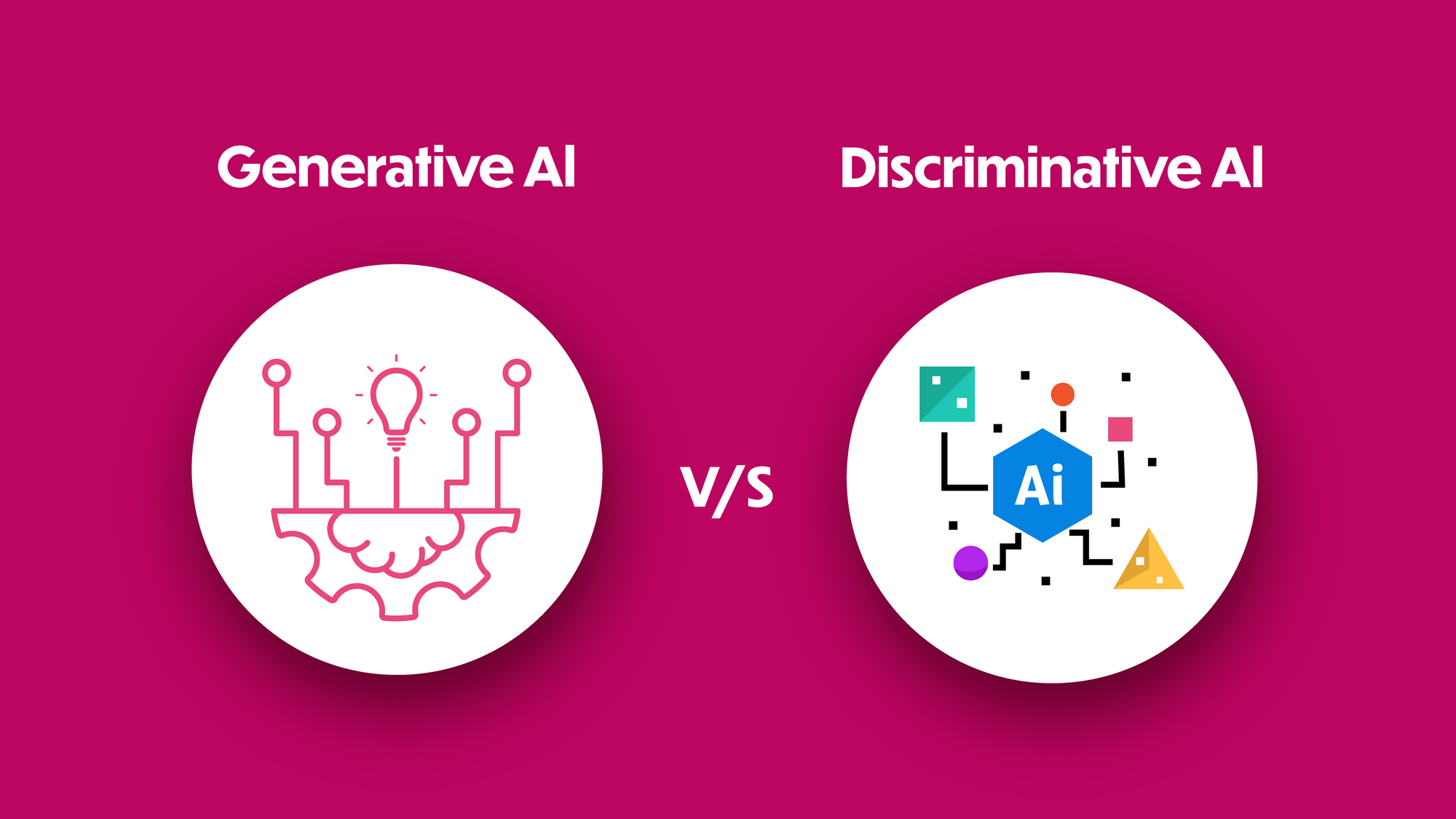Generative AI Vs Discriminative AI - GenAI Explorer
Explore the key differences between Generative AI and Discriminative AI with our comprehensive guide. Understand their unique functions, applications, and how they shape the future of AI technology. Perfect for AI enthusiasts and professionals alike.

When people speak of GenAI capabilities, they generally tend to focus on generating a particular piece of content such as text, images, reports, audio or video, and in some cases, simulations. But, more often than not, an equally capable, and more commonly used technology gets left out of the spotlight. The clear reference here is made to discriminative artificial intelligence, which, when applied correctly, functions as a captain that steers the GenAI ship in the right direction.
Think of GenAI as the only source of wisdom—an all-knowing sage of intelligence, if you will—that provides answers to any query, interlinking every relevant data point to that query, referencing all supporting pieces of information possible. But, human comprehension skills are limited, and hence, consumption of such vast data becomes challenging, and deriving meaningful, actionable insight that can be consumed by someone equally skilled in less time is yet another mountain to climb. A similar thought experiment is put to the test in the movie, Hitchhiker’s Guide to the Galaxy, where hyper-intelligent beings create Earth to function as a supercomputer that is tasked with finding the answer to the ultimate question of life, the universe, and everything. Although they succeeded in making the computer functional, the answer it provided lacked any context whatsoever and was so incomprehensible that no one could understand it. GenAI creations are very much similar, when the LLMs are trained on a vast enough data set; if trained on minimal data, accuracy is compromised due to the smaller sample size of data, and when trained on abundant information, the answer can be abstract, generic, or lacking actionable meaning.
Every prompt engineer working with GenAI tools has struggled to surpass this barrier of access to information, whereby, regardless of the structure of the query, the resultant output from any GenAI framework is barely useable at an enterprise level to drive revenue or value. What is the solution to this problem, you ask? Refining Gen AI LLMs with Discriminative Intelligence.
At this juncture, utilisation of GenAI in terms of resource efficiency is of paramount importance for any business leader planning to implement Generative or Discriminative Intelligence.
That is, if 10 data scientists are required to create a Generative Intelligence model, the salaries incurred in bringing such a solution to life, the technological resources consumed in development, and its lifecycle management expenditure, collectively, should result in a solution that at the very least brings twice or thrice the value. Only then, does building such a solution make sense in the business world. Great evidence is shown for this hypothesis in the number of organisations investing valuable resources to train such algorithms; organisations that have the monetary resources to try and test the market for product feasibility, who are prepared to incur experimental expenses along the way, and who are ready to navigate the biases of the marketplace. All this effort is to understand if such intelligence solutions have viable use cases or not, thereby aspiring to create revenue pipelines in the long run. Now, business leaders such as Codemonk understand the open source LLMs available in the marketplace to develop discriminative algorithms on top of the generative framework to refine obtained results for much easier consumption and utilisation across enterprise applications. Before we dive into such application exemplars, here is a quick overview of the two frameworks and what they offer as a piece of technology.
Comparative Table
| Feature | Generative AI | Discriminative AI |
|---|---|---|
| Definition | Creates new data instances similar to training data | Classifies data into predefined categories |
| Goal | Generate new samples | Make predictions or decisions |
| Output | New data instances (e.g., images, text, audio) | Class labels or probabilities |
| Common Techniques | Generative Adversarial Networks (GANs), Variational Autoencoders (VAEs), Normalizing Flows, and Autoregressive Models | Logistic Regression, Support Vector Machines (SVMs), Naive Bayes, Decision Trees, and Neural Networks |
| Applicability | Image generation, text generation, music composition, drug discovery, data augmentation | Image classification, spam filtering, fraud detection, customer churn prediction, and sentiment analysis |
| Pros | Can generate diverse and creative outputs, useful for data augmentation. | High accuracy, efficient for large datasets, and well-understood algorithms |
| Cons | Can be computationally expensive, difficult to control output quality, and have the and have the potential to generate misleading content. | Can be sensitive to imbalanced data and less flexible for complex patterns. |
| Frameworks | TensorFlow, PyTorch, and Keras | TensorFlow, PyTorch, Scikit-learn |
| Advantages | Creates new possibilities, drives innovation, and enhances creativity. | Reliable, efficient, and widely used |
| Implementation Techniques | Data preprocessing, model architecture selection, hyperparameter tuning, and evaluation metrics | Data preprocessing, feature engineering, model selection, and performance evaluation |
| Best Practices | Clear objectives, diverse and high-quality data, careful model design, and ethical considerations | Data quality, feature engineering, model validation, and bias mitigation |
| Examples | Image generation, style transfer, text summarization, machine translation, drug discovery | Image classification, spam filtering, fraud detection, recommendation systems, sentiment analysis |
As we can clearly observe, generative AI focuses on creating new data samples that resemble the training data, while discriminative AI aims to classify data into predefined categories based on learned patterns. One could say that generative AI excels in tasks requiring creativity and data generation, such as art, design, and drug discovery; while its counterpart, discriminative AI, is primarily used for decision-making and prediction, like spam filtering, fraud detection, and customer segmentation.
Lets consider Codemonk’s very own Video AI based InScene Intelligence solution, which ingests vasts amount of video footage to categorise information in the most meaningful and contextually appropriate structure.
💡 ‘Opening a dialogue with the video itself, the intelligence framework could recognise the contents of the video and suitably respond with answers relevant to the context provided. For example, when fed with a sporting video such as a Cricket Match footage, Codemonk’s InScene intelligence could understand the actions performed on screen as the video played out, producing text-based commentary for events occurring during playback. It could produce engaging, statistical, and contextual commentary for Cricket matches, thereby augmenting a text-to-speech engine to produce life-like commentary in an audio format.’
Generative AI, when coupled with Discriminative Intelligence, is similar to the all knowing sage now possessing the capability to make humans understand fully any piece of information in the most elegant, useful, contextual, and actionable format. Without Discriminative AI, the all knowing sage could only extract all the knowledge necessary to solve a problem, but with discriminative AI, the sage can also direct humans toward the most efficient route to be taken in solving problems.
This advantage adds another layer of value over the already excellent Generative AI capabilities known to the business world. A derivative of this raw capability is Intelligent customer support, tailored to improve the experiences created by products and services. For instance, within the customer experience journey, a business would invariably find multiple touchpoints, whereby interaction with customers is recorded using telephonic conversations. These conversations could involve resolving customer grievances, assisting them in procuring a particular service as intended by the service provider, or utilizing a product to obtain tangible value in an enterprise. Businesses looking at such touchpoints would have to dedicate skilled labor to gather insightful information on a daily basis, which is then acted upon to enhance the overall customer experience. More often than not, such activities consume both time and essential resources.
GenAI and discriminative AI in congruence with one another prove to be a game changer in quickly obtaining the aforementioned actionable intelligence, at a customer level or at the collective level, wherein pools of customer engagement data are recorded and analysed to improve products and services across successive iterations. The capabilities showcased through this effort would summarise all information collected and present it as actionable manner, as detailed by the user through the chat interface built in. The user could put forth any queries pertaining to the collected data and obtain meaningful responses through direct question and answer (Q&A). The Sentiment Analysis module featured in Codemonk’s Video Intelligence (VideoAI), helps understand customer requests better, allowing responders to react and provide equivalent resolutions.
Collectively, armed with the combination of GenAI and Discriminative Intelligence, businesses can develop Knowledge Management Bots that contextually understand the nature of a business and equally respond to employees who can query the bot for specific information. A digital twin, or a Private GPT framework is created, which would allow an employee to access all relevant information pertaining to the company, a specific business line or product or service offered, or even related to any intellectual property. Driven by a Question and Answer interface, the employee could speak to the knowledge management Bot, taking into consideration the Document QnA functionality, which can access information stored within specific file systems as well.
Codemonk continues to develop such utilitarian use cases that doubles down on the potential applicability of GenAI, in tandem with similar contemporary applications of artificial intelligence such as discriminative intelligence. Our collaborations with enterprise that craft business specific solutions have allowed us to test the waters of applicability by conducting our own market feasibility for any capability being developed. Ultimately, when engaging with Codemonk, business can expect fully furnished set of GenAI and contemporary machine learning use cases that resolve critical bottlenecks, while also bringing in the much needed operational resilience automation can bring to any business.

